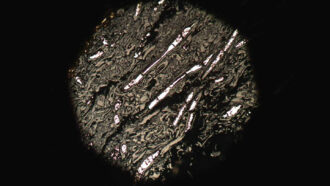
Bits of charcoal entombed in ancient rocks unearthed in Wales and Poland push back the earliest evidence for wildfires to around 430 million years ago. Besides breaking the previous record by about 10 million years, the finds help pin down how much oxygen was in Earth’s atmosphere at the time.
The ancient atmosphere must have contained at least 16 percent oxygen, researchers report June 13 in Geology. That conclusion is based on modern-day lab tests that show how much oxygen it takes for a wildfire to take hold and spread.
While oxygen makes up 21 percent of our air today, over the last 600 million years or so, oxygen levels in Earth’s atmosphere have fluctuated between 13 percent and 30 percent (SN: 12/13/05). Long-term models simulating past oxygen concentrations are based on processes such as the burial of coal swamps, mountain building, erosion and the chemical changes associated with them. But those models, some of which predict lower oxygen levels as low as 10 percent for this time period, provide broad-brush strokes of trends and may not capture brief spikes and dips, say Ian Glasspool and Robert Gastaldo, both paleobotanists at Colby College in Waterville, Maine.
Charcoal, a remnant of wildfire, is physical evidence that provides, at the least, a minimum threshold for oxygen concentrations. That’s because oxygen is one of three ingredients needed to create a wildfire. The second, ignition, came from lightning in the ancient world, says Glasspool. The third, fuel, came from burgeoning plants and fungus 430 million years ago, during the Silurian Period. The predominant greenery were low-growing plants just a couple of centimeters tall. Scattered among this diminutive ground cover were occasional knee-high to waist-high plants and Prototaxites fungi that towered up to nine meters tall. Before this time, most plants were single-celled and lived in the seas.
Once plants left the ocean and began to thrive, wildfire followed. “Almost as soon as we have evidence of plants on land, we have evidence of wildfire,” says Glasspool.
That evidence includes tiny chunks of partially charred plants — including charcoal as identified by its microstructure — as well as conglomerations of charcoal and associated minerals embedded within fossilized hunks of Prototaxites fungi. Those samples came from rocks of known ages that formed from sediments dumped just offshore of ancient landmasses. This wildfire debris was carried offshore in streams or rivers before it settled, accumulated and was preserved, the researchers suggest.
The microstructure of this fossilized and partially charred bit of plant unearthed in Poland from sediments that are almost 425 million years old reveals that it was burnt by some of Earth’s earliest known wildfires.Ian Glasspool/Colby College
The discovery adds to previous evidence, including analyses of pockets of fluid trapped in halite minerals formed during the Silurian, that suggests that atmospheric oxygen during that time approached or even exceeded the 21 percent concentration seen today, the pair note.
“The team has good evidence for charring,” says Lee Kump, a biogeochemist at Penn State who wasn’t involved in the new study. Although its evidence points to higher oxygen levels than some models suggest for that time, it’s possible that oxygen was a substantial component of the atmosphere even earlier than the Silurian, he says.
“We can’t rule out that oxygen levels weren’t higher even further back,” says Kump. “It could be that plants from that era weren’t amenable to leaving a charcoal record.”

 A new treatment could restore some mobility in people paralyzed by strokes
A new treatment could restore some mobility in people paralyzed by strokes  What has Perseverance found in two years on Mars?
What has Perseverance found in two years on Mars?  This robot automatically tucks its limbs to squeeze through spaces
This robot automatically tucks its limbs to squeeze through spaces  Greta Thunberg’s new book urges the world to take climate action now
Greta Thunberg’s new book urges the world to take climate action now  Glassy eyes may help young crustaceans hide from predators in plain sight
Glassy eyes may help young crustaceans hide from predators in plain sight  A chemical imbalance doesn’t explain depression. So what does?
A chemical imbalance doesn’t explain depression. So what does?